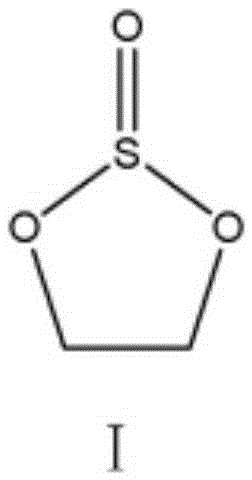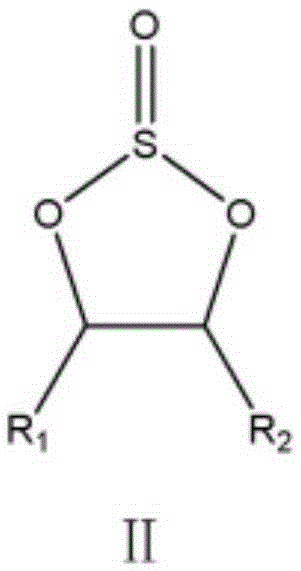Lithium ion battery electrolyte and preparation method thereof
A lithium-ion battery and electrolyte technology, applied in the field of lithium-ion battery electrolyte and its preparation, can solve the problems of lithium-ion battery cycle performance degradation, inability to form stable, graphite layer peeling, etc., to broaden temperature adaptability and improve stability performance and increase capacity
- Summary
- Abstract
- Description
- Claims
- Application Information
AI Technical Summary
Problems solved by technology
Method used
Image
Examples
Embodiment 1
[0048] A lithium-ion battery electrolyte, based on the total mass of organic solvents and additives as 100%, wherein the components and their mass percentages are as follows: ethylene carbonate is 23%, ethyl methyl carbonate is 57%, butene sulfite The ester is 20%, and the concentration of lithium difluorooxalate borate (LiODFB) in the electrolyte is 1mol / L; under the protection of argon, mix the components in proportion in a glove box to prepare the electrolyte.
[0049] Assemble 10 sets of button batteries, and conduct charge and discharge tests on 10 sets of button batteries at room temperature through the blue electric battery test system at a current density of 0.1C. After 10 weeks of testing, the average capacity of the button cell is 360mAh / g.
[0050] Another 10 sets of button batteries were assembled, and the charge and discharge tests of 10 sets of button batteries were carried out at a current density of 0.1C through the blue electric battery test system under low tem...
Embodiment 2
[0052] A lithium-ion battery electrolyte, based on the total mass of organic solvents and additives as 100%, wherein the components and their mass percentages are as follows: ethylene carbonate is 20%, ethyl methyl carbonate is 50%, butene sulfite The ester is 30%, and the concentration of lithium difluorooxalate borate (LiODFB) in the electrolyte is 1mol / L; under the protection of argon, mix the components in proportion in a glove box to prepare the electrolyte.
[0053] Assemble 10 sets of button batteries, and conduct charge and discharge tests on 10 sets of button batteries at room temperature through the blue electric battery test system at a current density of 0.1C. After 10 weeks of testing, the button battery has an average capacity of 354mAh / g.
[0054] Another 10 sets of button batteries were assembled, and the charge and discharge tests of 10 sets of button batteries were carried out at a current density of 0.1C through the blue electric battery test system under lo...
Embodiment 3
[0056] A lithium-ion battery electrolyte, based on the total mass of organic solvents and additives as 100%, wherein the components and their mass percentages are as follows: ethylene carbonate is 30%, dimethyl carbonate is 69.5%, propylene sulfite The concentration of lithium diacetate borate (LiBOB) in the electrolyte is 0.5%, and the concentration of the substance in the electrolyte is 0.6mol / L; under the protection of argon, the components are mixed in proportion in the glove box to prepare the electrolyte.
[0057] Assemble 10 sets of button batteries, and conduct charge and discharge tests on 10 sets of button batteries at room temperature through the blue electric battery test system at a current density of 0.1C. After 10 weeks of testing, the button battery has an average capacity of 243mAh / g.
[0058] Another 10 sets of button batteries were assembled, and the charge and discharge tests of 10 sets of button batteries were carried out at a current density of 0.1C throu...
PUM
 Login to View More
Login to View More Abstract
Description
Claims
Application Information
 Login to View More
Login to View More - R&D
- Intellectual Property
- Life Sciences
- Materials
- Tech Scout
- Unparalleled Data Quality
- Higher Quality Content
- 60% Fewer Hallucinations
Browse by: Latest US Patents, China's latest patents, Technical Efficacy Thesaurus, Application Domain, Technology Topic, Popular Technical Reports.
© 2025 PatSnap. All rights reserved.Legal|Privacy policy|Modern Slavery Act Transparency Statement|Sitemap|About US| Contact US: help@patsnap.com



